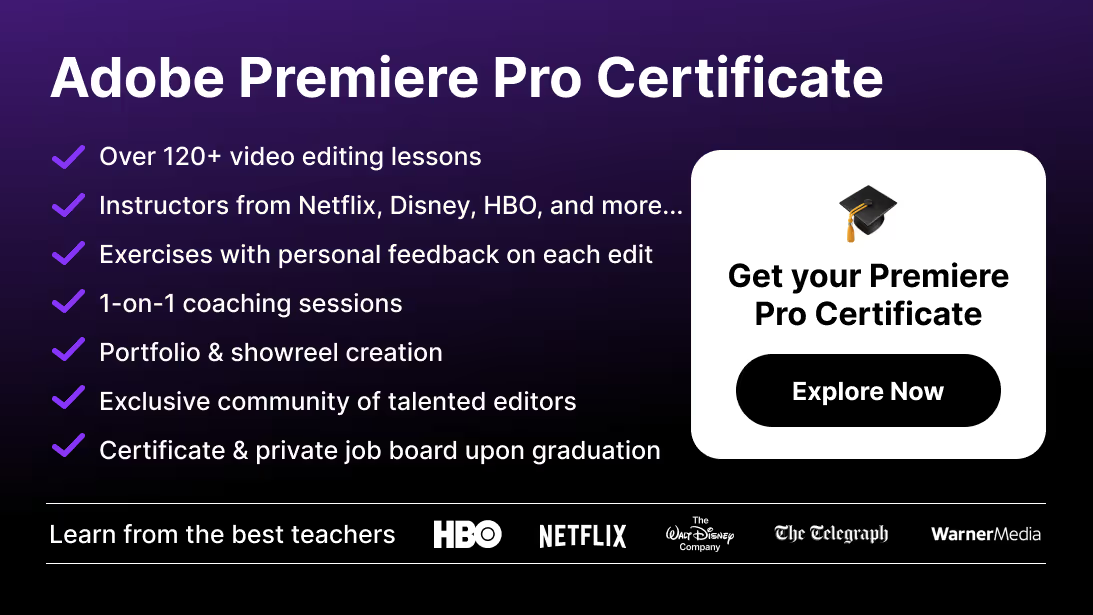If you’re editing regularly in Adobe Premiere Pro, you already know how much time it takes to build your project setup, import assets, organize sequences, and apply your favorite transitions, titles, and effects — every single time.
That’s where Premiere Pro templates come in. Templates let you automate your workflow, save hours per project, maintain brand consistency, and scale your editing whether you’re working solo, freelancing, or collaborating with a team.
Before building templates, make sure your editing environment is optimized—here’s the best Premiere Pro workspace layout to streamline your workflow.
This guide will show you exactly how to make a Premiere Pro template — from creating reusable sequences to building dynamic motion graphics templates (MOGRTs), optimizing for speed, and exporting your template for reuse or sharing. Let’s dive in.
Step-by-Step: How to Make a Premiere Pro Template
A. Building a Project Template
- Create a new project → Set up folders for footage, audio, graphics, and exports.
- Add a new sequence with your preferred settings (e.g. 1920×1080, 24 fps, or 9:16 for vertical videos).
- Organize your assets — include placeholder footage, intro animations, and branded overlays.
- Add essential elements:
- Lower third placeholders
- Branded color correction LUTs
- Audio equalizer presets
- Key transition presets
- Label everything clearly (e.g. “Intro_Sequence”, “Outro”, “Main_Edit”).
- Save your project as a template:
- Go to File → Save As and name it “Premiere_Template_Master.prproj”.
- Store it in a dedicated “Templates” folder.
You can also fill your template with high-quality transitions—here are some of the best free Premiere Pro transitions packs to use in your edits.
B. Creating Motion Graphics Templates (MOGRTs)
- Open Essential Graphics Panel → Design your text/title animation.
- Add keyframes, effects, or transitions.
- Select all layers → Right-click → Export as Motion Graphics Template.
- Save it to your local drive or the Essential Graphics Library for future use.
- You can now apply your animation instantly in any project and modify its parameters (like text or color) without reanimating.
C. Building Adjustment Layer Presets
- Add an Adjustment Layer in your project.
- Apply color grading, motion blur, sharpening, or cinematic filters.
- Save it as a preset by right-clicking → Save Preset.
- Drag and drop it into any new sequence.
If you want ready-made effects you can plug directly into your templates, check out these free Premiere Pro presets.
Advanced Tips for Professional Templates
1. Use Naming Conventions
Label your assets clearly (e.g. “LWR_THIRD_V1”, “MAIN_INTRO_16x9”). It keeps projects scalable and easy for team use.
2. Create Placeholder Media
Include text placeholders or dummy clips labeled “Replace Me” to make reuse intuitive.
3. Automate via Dynamic Links
Link your Premiere template with After Effects for advanced animations that automatically update when changed in AE.
4. Include a Sound Design Base
Add sound effect layers (swishes, hits, whooshes) so your future edits already have a sonic foundation.
5. Build Multiple Versions
Create templates for every format:
- YouTube 16:9 (1920×1080)
- TikTok/Reels 9:16 (1080×1920)
- Square 1:1 (1080×1080)
6. Make It Team-Friendly
If you’re part of an agency or production team, store templates in a shared drive or cloud system with version control.
To take your templates even further, consider enhancing them with some of the best Premiere Pro plugins for speed, automation, and creative effects.
Common Mistakes to Avoid
- Cluttering the project: Keep only essential assets in the template file.
- Using unlinked media: Store assets in the same folder as the project to avoid missing files.
- Not versioning templates: Keep version history (e.g. “Template_v2.3”).
- Hard-coding text layers: Use editable placeholders in MOGRTs instead.
- Ignoring platform specs: Adjust export settings for each platform before saving templates.
Template Optimization Checklist
- Folder and file structure organized
- Placeholder footage included
- Text and color schemes locked
- LUTs and effects saved
- Presets for transitions and animations
- Sound design base added
- MOGRT files tested and exported
- Template version labeled clearly
Why You Should Use Premiere Pro Templates
Save Hours on Repetitive Tasks
Templates let you skip repetitive setups — intros, lower-thirds, transitions, and text animations. Build it once, reuse it forever.
Ensure Consistency Across Projects
Whether you're editing YouTube videos, brand content, or client deliverables, templates help maintain a consistent visual identity — fonts, colors, transitions, and pacing stay uniform.
Collaborate and Scale Effortlessly
Premiere Pro templates make collaboration easier: team members can use the same assets and sequences without breaking style or structure.
Create a Professional Editing System
Building your own templates forces you to structure your projects efficiently, resulting in smoother editing, faster renders, and fewer errors.
Types of Templates in Premiere Pro
Project Templates (.prproj)
These are complete project files containing prebuilt sequences, folders, and assets. Perfect for consistent video structures like vlogs, ads, or tutorials.
Sequence Templates
Custom timelines with your usual settings (resolution, FPS, aspect ratio, and layers) — ideal for specific formats like YouTube Shorts (9:16) or cinematic projects (21:9).
Motion Graphics Templates (.mogrt)
Dynamic, editable graphics built in Premiere Pro or After Effects. They allow quick customization of titles, intros, and lower thirds directly in the Essential Graphics Panel.
Adjustment Layer Templates
Pre-styled color grading or effect layers (LUTs, transitions, motion blur presets) that can be dropped onto any clip.
You can explore more ready-to-use structures and graphics inside our dedicated collection of Premiere Pro templates.
Why Mastering Templates Transforms Your Editing Career
Professional video editors use templates not just to save time, but to build scalable editing systems. By mastering template creation, you can:
- Deliver consistent results faster
- Maintain brand integrity for clients
- Scale your production for multiple deliverables
- Build your own template library for resale or content packs
- Free up time for storytelling and creative work
Templates turn Premiere Pro from an editing tool into a full production workflow engine — allowing you to focus on creative direction instead of repetitive setup.
Conclusion
Creating Premiere Pro templates is one of the most valuable skills for modern editors. With well-built templates, you can transform your workflow — producing consistent, high-quality videos in a fraction of the time.
If you want to go beyond templates and master every aspect of editing, storytelling, and professional post-production, join our Adobe Premiere Pro course at Miracamp. Learn from industry experts who’ve worked with top studios and turn your editing skills into a powerful creative career.
FAQ — Premiere Pro Templates
What is a Premiere Pro template?
A pre-built project or animation setup that can be reused across different videos without recreating elements manually.
Can I make my own templates in Premiere Pro?
Yes. You can create your own project, then save it as a reusable template or export graphics as MOGRT files.
Are Premiere Pro templates free to make?
Yes. You don’t need any paid add-ons to build templates — everything is built into Premiere Pro and After Effects.
What are MOGRT files?
MOGRT stands for Motion Graphics Template — a file that contains editable motion design elements like titles, intros, or lower thirds.
Can I share my templates with others?
Yes, you can share .prproj or .mogrt files via shared drives or libraries so others can import them into their own projects.
Can I sell Premiere Pro templates?
Definitely. Many editors sell templates on platforms like Envato, Motion Array, or Gumroad.
How do I edit a saved template?
Open the project, replace the placeholder media, and save it under a new name to preserve your master version.
What’s the best structure for a template project?
Use folders for assets (video, audio, graphics), sequences, and exports. Keep everything organized from the start.
Can I make templates for vertical videos?
Yes. Create a 9:16 sequence and save it as a preset or template for future TikTok/Reels content.
How do I include my brand colors and fonts?
Set up your Essential Graphics panel with your brand kit and save it as a style preset.
Can templates include sound design?
Yes. Add sound effect layers to make your templates feel polished and professional.
What’s the difference between a preset and a template?
Presets save effect or motion settings, while templates store entire project structures or motion graphics compositions.
Do I need After Effects to make MOGRTs?
No — you can create simple MOGRTs directly in Premiere Pro. After Effects is only needed for more complex animations.
Can I use someone else’s templates?
Yes, you can import templates made by others and adapt them to your own projects.
How do I organize multiple templates?
Create a dedicated folder system with clear naming, version control, and categories (e.g., intros, lower-thirds, color grades).






